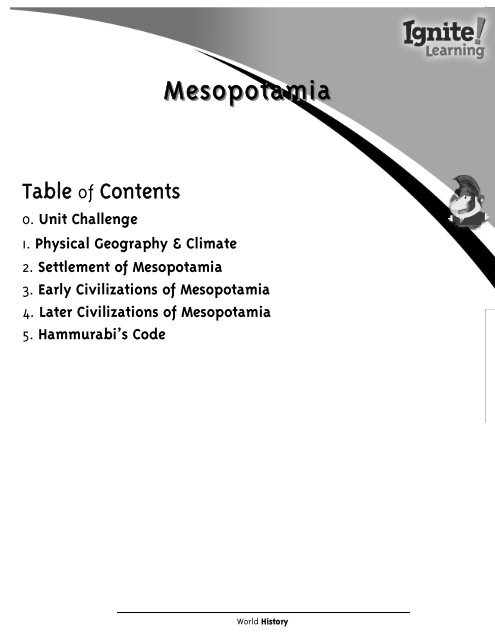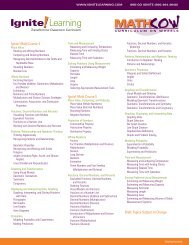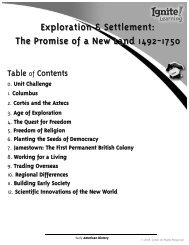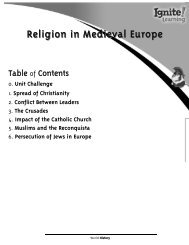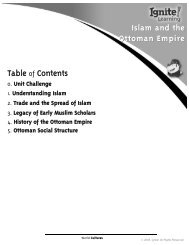Settlement of Mesopotamia Mesopotamia - Ignite!
Settlement of Mesopotamia Mesopotamia - Ignite!
Settlement of Mesopotamia Mesopotamia - Ignite!
Create successful ePaper yourself
Turn your PDF publications into a flip-book with our unique Google optimized e-Paper software.
Table <strong>of</strong> Contents<br />
0. Unit Challenge<br />
<strong>Mesopotamia</strong><br />
1. Physical Geography & Climate<br />
2. <strong>Settlement</strong> <strong>of</strong> <strong>Mesopotamia</strong><br />
3. Early Civilizations <strong>of</strong> <strong>Mesopotamia</strong><br />
4. Later Civilizations <strong>of</strong> <strong>Mesopotamia</strong><br />
5. Hammurabi’s Code<br />
World History
UNIT CHALLENGE<br />
Purpose: The unit challenges help students explore the big picture themes that tie together each unit <strong>of</strong><br />
<strong>Ignite</strong>! content. These challenges are designed to complement the <strong>Ignite</strong>! Topic Lessons.<br />
Each challenge presents students with an openended task with no single correct solution. Working in<br />
small groups, students prepare a short response, in either written or oral form, in which they use<br />
knowledge gained by studying the unit’s multimedia movies to formulate and defend a particular position.<br />
These responses can be used to stimulate further class discussion and exploration <strong>of</strong> the issues.<br />
NOTE: In order to use this activity with your class for a particular <strong>Ignite</strong>! unit, you should plan on<br />
having students study the <strong>Ignite</strong>! movies from most <strong>of</strong> the topics in that unit. Otherwise, students<br />
will not have enough information to complete the challenge activity.<br />
Class time required:<br />
• 15 minutes at the start <strong>of</strong> unit to organize students into groups and review the challenge, and for<br />
the groups to discuss and record their initial thoughts and current knowledge <strong>of</strong> the issues.<br />
• 20 minutes at the end <strong>of</strong> the unit for student groups to complete their responses to the challenge.<br />
• Optional: 2030 minutes for student groups to present their responses to the class.<br />
Teacher Instructions:<br />
At the Start <strong>of</strong> the Unit: Before studying any <strong>of</strong> the unit’s topics or movies:<br />
1. divide your class into teams <strong>of</strong> 3 to 4 students;<br />
2. reproduce the unit challenge worksheet and distribute to students;<br />
3. decide whether teams will give oral presentations and/or written statements in response to their<br />
challenge;<br />
4. read the challenge(s) out loud and make sure that all terms and concepts are understood;<br />
5. ask groups to complete Part One <strong>of</strong> their worksheets (Getting Started). They should discuss and<br />
write down their thoughts, based on their current knowledge for how they might respond to the<br />
selected challenge.<br />
While the Class Studies the Unit’s Topics: Over the next few days or weeks, as you are using the <strong>Ignite</strong>!<br />
Topic Lessons for this unit, occasionally remind students to record on their worksheets any information<br />
they have found in the <strong>Ignite</strong>! movies that might help them to develop or support their response to the<br />
challenge. They should record this information in Part Two <strong>of</strong> their worksheets (Taking Notes).<br />
After Completing the Last Topic <strong>of</strong> the Unit: Give your students 20 minutes to discuss and write up their<br />
response to the challenge. They can use the space provided in Part Three <strong>of</strong> their worksheets (Preparing<br />
Your Response). You might consider allowing them to review some <strong>of</strong> the movies from the unit. Then,<br />
have students give brief presentations <strong>of</strong> their responses (2 to 3 minutes each) and/or submit their written<br />
responses.<br />
© 2005, <strong>Ignite</strong>! All Rights Reserved
Name:<br />
<strong>Mesopotamia</strong><br />
© 2005, <strong>Ignite</strong>! All Rights Reserved<br />
<strong>Mesopotamia</strong><br />
World History<br />
Challenge A: Come to <strong>Mesopotamia</strong>!<br />
Background: <strong>Mesopotamia</strong> was a land with a lot to <strong>of</strong>fer. Its location and natural resources encouraged<br />
people to settle there. Early societies developed governments, agriculture, writing, and new<br />
technologies. Over time the, civilizations grew larger and better organized.<br />
Challenge: Write an advertisement for "The Ancient Times" newspaper that convinces people in other parts<br />
<strong>of</strong> the world to move to ancient <strong>Mesopotamia</strong>.<br />
Tips:<br />
• Describe the benefits <strong>of</strong> the land and its location as well as advancements and inventions <strong>of</strong> the<br />
people who lived there. Explain how these things supported a good lifestyle.<br />
• Start with a short catchphrase that will stick in the listener's mind.<br />
• Be convincing, but stick to the facts.<br />
Challenge B: People and the Land<br />
Background: Throughout history, the land has shaped the lives <strong>of</strong> people living on it. Mountains, valleys,<br />
rivers, coasts, and climate all affect where and how people live. At the same time, people have<br />
changed and used the land for their own needs.<br />
Challenge: Describe the many different ways that the land was critical to the development <strong>of</strong> civilization in<br />
<strong>Mesopotamia</strong>.<br />
Tips:<br />
• You could consider its location, climate, water, and soil, as well as natural barriers that surrounded<br />
it.<br />
• For each feature you describe, explain how it helped civilizations to grow.<br />
PART ONE – Getting Started<br />
Directions: Choose one <strong>of</strong> the challenges above, or your teacher will assign you one. Based on what you<br />
already know, talk with the other members <strong>of</strong> your group about how you might respond to this challenge.<br />
Write your thoughts in the box below. You can change your mind later after you have reviewed the <strong>Ignite</strong>!<br />
movies in this unit.<br />
Notes:
Name:<br />
PART TWO – Taking Notes<br />
Directions: As you view and discuss the <strong>Ignite</strong>! movies in this unit, be on the lookout for information that<br />
will help you develop a response to your challenge. Record that information in the box below. Use<br />
additional paper if necessary.<br />
Notes:<br />
PART THREE – Preparing Your Response<br />
Directions: Depending on your teacher’s instructions, work with your group to create a written or oral<br />
response to your challenge. Decide on the argument you wish to make or the position you wish to take,<br />
and be sure to include evidence from the <strong>Ignite</strong>! movies to support your statements. Use the space below<br />
for your response. Use additional paper if necessary.<br />
Notes:<br />
© 2005, <strong>Ignite</strong>! All Rights Reserved<br />
<strong>Mesopotamia</strong><br />
World History
World History<br />
Lesson Plan<br />
# 1.<br />
unit<br />
<strong>Mesopotamia</strong><br />
Physical Geography & Climate<br />
Class: _________________ Type Instruction: Whole Class<br />
Learning Objective(s): Students understand the influence <strong>of</strong> geography on the location <strong>of</strong> <strong>Mesopotamia</strong> in the Fertile<br />
Crescent.<br />
Length <strong>of</strong> Time: 10 Minutes<br />
<strong>Ignite</strong>! Movies:<br />
• <strong>Mesopotamia</strong>’s Fertile Land<br />
• Mapping <strong>Mesopotamia</strong><br />
• Locating <strong>Mesopotamia</strong><br />
Teacher Instructions: Play <strong>Ignite</strong>! movies with students and complete the following activity.<br />
Part One: Students correctly label items on the map.<br />
Part Two: Students use their work from Part One to write an email.<br />
Target Vocabulary/Key Terms:<br />
Notes:<br />
• Cradle <strong>of</strong> Civilization • Syrian Desert<br />
• Euphrates River • Taurus Mountains<br />
• Fertile Crescent • Tigris River<br />
• fertility • Zagros Mountains<br />
• <strong>Mesopotamia</strong><br />
© 2005, <strong>Ignite</strong>! All Rights Reserved<br />
<strong>Mesopotamia</strong><br />
Physical Geography & Climate<br />
World History
Name:<br />
Directions: Label the following places on the map:<br />
1. Tigris River<br />
2. Euphrates River<br />
3. <strong>Mesopotamia</strong><br />
4. Fertile Crescent<br />
5. Syrian Desert<br />
Directions: Complete the statements about <strong>Mesopotamia</strong>.<br />
<strong>Mesopotamia</strong>: The Cradle <strong>of</strong> Civilization<br />
© 2005, <strong>Ignite</strong>! All Rights Reserved<br />
<strong>Mesopotamia</strong><br />
Physical Geography & Climate<br />
1. <strong>Mesopotamia</strong> means ______________________________________________________.<br />
World History<br />
2. The combination <strong>of</strong> ____________ soil and ____________ from the rivers made <strong>Mesopotamia</strong> the<br />
most _________________ farmland in the region.<br />
3. The surrounding land is mostly _____________________________________________.<br />
4. The Fertile Crescent was an area with ___________________________________. Ancient people<br />
built large ____________________ here.<br />
5. <strong>Mesopotamia</strong> was located in the modern countries <strong>of</strong> ___________________________,<br />
_______________________, and ________________________.<br />
6. Northwest <strong>Mesopotamia</strong>: people used water to _________________the land.<br />
7. Southwest <strong>Mesopotamia</strong>: the Tigris and Euphrates rivers ________________ before they flow into<br />
the ________________________________. It is an area <strong>of</strong> _____________________________.<br />
8. Without the rivers, the whole area would be a __________________________________.<br />
9. Today, modern practices <strong>of</strong> _________________________ rivers and ____________________ the<br />
marshland are __________________________ the area.
Name:<br />
The Cradle <strong>of</strong> Civilization<br />
© 2005, <strong>Ignite</strong>! All Rights Reserved<br />
<strong>Mesopotamia</strong><br />
Physical Geography & Climate<br />
World History<br />
Directions: Imagine that you are visiting the area where <strong>Mesopotamia</strong> was located. Write an email describing how<br />
geography affected civilization in the area. Why was it called the “Cradle <strong>of</strong> Civilization? What is happening to the<br />
land now? How will this change the land?<br />
To:<br />
CC:<br />
Subject:<br />
New Message<br />
New Message
\World History<br />
Lesson Plan<br />
unit<br />
# 2.<br />
<strong>Mesopotamia</strong><br />
<strong>Settlement</strong> <strong>of</strong> <strong>Mesopotamia</strong><br />
Class: _________________ Type Instruction: Whole Class<br />
Learning Objective(s): Students understand and identify the geographic and cultural factors that led to the<br />
development <strong>of</strong> the <strong>Mesopotamia</strong>n civilization.<br />
Length <strong>of</strong> Time: 10 Minutes<br />
<strong>Ignite</strong>! Movies:<br />
• Civilization from Dirt<br />
• <strong>Mesopotamia</strong>n Civilization<br />
• The People or the Place?<br />
Teacher Instructions: Play <strong>Ignite</strong>! movies with students and complete the following activity.<br />
Part One: Students complete cause and effect chart.<br />
Part Two: Students use their notes from Part One to create a poster about goods that were traded in <strong>Mesopotamia</strong>.<br />
Students present and display their posters to the class.<br />
Target Vocabulary/Key Terms:<br />
Notes:<br />
• agriculture • merchants<br />
• cuneiform • Sumerians<br />
• division <strong>of</strong> labor • surplus<br />
• Irrigate<br />
© 2005, <strong>Ignite</strong>! All Rights Reserved<br />
<strong>Mesopotamia</strong><br />
<strong>Settlement</strong> <strong>of</strong> <strong>Mesopotamia</strong><br />
World History
Name:<br />
The <strong>Settlement</strong> <strong>of</strong> <strong>Mesopotamia</strong><br />
© 2005, <strong>Ignite</strong>! All Rights Reserved<br />
<strong>Mesopotamia</strong><br />
<strong>Settlement</strong> <strong>of</strong> <strong>Mesopotamia</strong><br />
World History<br />
Directions: Fill out the Cause & Effect chart below about the development <strong>of</strong> the <strong>Mesopotamia</strong>n civilization.<br />
Cause: Describe the topic.<br />
Effect: Describe how it influenced <strong>Mesopotamia</strong>.<br />
Describe the soil:<br />
And water:<br />
Crops:<br />
Surplus:<br />
Abundant materials:<br />
Trade:<br />
Government:<br />
CAUSE EFFECT<br />
Soil and Water<br />
Agriculture<br />
Mud and Clay<br />
Development <strong>of</strong> Civilization<br />
Huntergatherers<br />
decided to:<br />
Division <strong>of</strong> Labor:<br />
Trade:<br />
Artists:<br />
How they used it:<br />
Cuneiform:
Name:<br />
The <strong>Settlement</strong> <strong>of</strong> <strong>Mesopotamia</strong><br />
© 2005, <strong>Ignite</strong>! All Rights Reserved<br />
<strong>Mesopotamia</strong><br />
<strong>Settlement</strong> <strong>of</strong> <strong>Mesopotamia</strong><br />
World History<br />
Directions: Imagine that you are a member <strong>of</strong> the new merchant class in <strong>Mesopotamia</strong>. Make an advertisement for<br />
the items you sell and trade. Make up a title, a slogan, and include information about the crops and art in your<br />
collection <strong>of</strong> goods.
World History<br />
Lesson Plan<br />
# 3.<br />
unit<br />
<strong>Mesopotamia</strong><br />
Early Civilizations <strong>of</strong> <strong>Mesopotamia</strong><br />
Class: _________________ Type Instruction: Whole Class<br />
Learning Objective(s): Students examine the Sumerian and Babylonian civilizations.<br />
Length <strong>of</strong> Time: 10 Minutes<br />
<strong>Ignite</strong>! Movies:<br />
• The Sumerian Civilization<br />
• King Hammurabi <strong>of</strong> Babylonia<br />
• <strong>Mesopotamia</strong>n Rap<br />
Teacher Instructions: Play <strong>Ignite</strong>! movies with students and complete the following activity.<br />
Part One: Students complete a graphic organizer with facts describing the Sumerian civilization.<br />
Part Two: Students answer questions about the Sumerian civilization.<br />
Target Vocabulary/Key Terms:<br />
Notes:<br />
• Amorites • Etana<br />
• Babylonians • Polytheistic<br />
• cuneiform • Ziggurats<br />
© 2005, <strong>Ignite</strong>! All Rights Reserved<br />
<strong>Mesopotamia</strong><br />
Early Civilizations <strong>of</strong> <strong>Mesopotamia</strong><br />
World History
Name:<br />
The Sumerian Civilization<br />
© 2005, <strong>Ignite</strong>! All Rights Reserved<br />
<strong>Mesopotamia</strong><br />
Early Civilizations <strong>of</strong> <strong>Mesopotamia</strong><br />
World History<br />
Directions: Fill in the diagram with information describing the government, technology, daily life, and writing <strong>of</strong> the<br />
Sumerians.<br />
Agriculture<br />
Trade<br />
Technology<br />
Dates<br />
Location<br />
The<br />
Sumerians<br />
Cuneiform<br />
CityStates<br />
Form <strong>of</strong><br />
Government
Name:<br />
The Sumerian Civilization<br />
© 2005, <strong>Ignite</strong>! All Rights Reserved<br />
<strong>Mesopotamia</strong><br />
Early Civilizations <strong>of</strong> <strong>Mesopotamia</strong><br />
Directions: Which <strong>of</strong> the following statements best describes the Sumerian government?<br />
Circle “Option A” or “Option B” to show the correct answer.<br />
Option A:<br />
The Sumerians had the world’s first<br />
democracy, probably because they lived<br />
so close to each other between the Tigris<br />
and Euphrates Rivers.<br />
Option B:<br />
Directions: Which <strong>of</strong> the following statements best describes cuneiform?<br />
Circle “Option A” or “Option B” to show the correct answer.<br />
Option A:<br />
Cuneiform writing was made by pressing<br />
wedgeshaped characters into s<strong>of</strong>t clay<br />
tablets that were dried in the sun. Some <strong>of</strong><br />
them still exist today. It was invented by<br />
the Sumerians and copied by later<br />
civilizations.<br />
The Sumerian civilization was a collection<br />
<strong>of</strong> separate citystates. Due to their<br />
rivalries, they needed powerful leaders,<br />
such as kings, to unite them.<br />
Option B:<br />
Cuneiform writing was made by pressing<br />
wedgeshaped characters into s<strong>of</strong>t clay<br />
tablets that were then dried in the sun.<br />
Cuneiform was invented by the<br />
Babylonians, long after the Sumerian<br />
civilization ended.<br />
World History
World History<br />
Lesson Plan<br />
# 4.<br />
unit<br />
<strong>Mesopotamia</strong><br />
Later Civilizations <strong>of</strong> <strong>Mesopotamia</strong><br />
Class: _________________ Type Instruction: Whole Class<br />
Learning Objective(s): Students trace the later civilizations <strong>of</strong> <strong>Mesopotamia</strong> including rule by the Assyrians,<br />
Chaldeans, Persians, and Alexander the Great.<br />
Length <strong>of</strong> Time: 10 Minutes<br />
<strong>Ignite</strong>! Movies:<br />
• <strong>Mesopotamia</strong>: Land Changes Hands<br />
• <strong>Mesopotamia</strong>: Who Ruled When?<br />
• People <strong>of</strong> <strong>Mesopotamia</strong><br />
Teacher Instructions: Play <strong>Ignite</strong>! movies with students and complete the following activity.<br />
Part One: Students complete a timeline about the later civilizations <strong>of</strong> <strong>Mesopotamia</strong>.<br />
Part Two: Students write an overview <strong>of</strong> the later civilizations <strong>of</strong> <strong>Mesopotamia</strong>. Students share their introductions with<br />
the class.<br />
Target Vocabulary/Key Terms:<br />
Notes:<br />
• Alexander the Great • Hanging Gardens<br />
• Assyrian Empire • King Nebuchadnezzar II<br />
• Astrology • Macedonia<br />
• Chaldean Empire • Persian Empire<br />
© 2005, <strong>Ignite</strong>! All Rights Reserved<br />
<strong>Mesopotamia</strong><br />
Later Civilizations <strong>of</strong> <strong>Mesopotamia</strong><br />
World History
<strong>Mesopotamia</strong><br />
World History<br />
Name:<br />
Later Civilizations <strong>of</strong> <strong>Mesopotamia</strong><br />
Later Civilizations <strong>of</strong> <strong>Mesopotamia</strong><br />
Directions: Write facts describing each <strong>of</strong> the civilizations that ruled <strong>Mesopotamia</strong> between 650 B.C. and 331 B.C.
Name:<br />
Welcome to <strong>Mesopotamia</strong><br />
© 2005, <strong>Ignite</strong>! All Rights Reserved<br />
<strong>Mesopotamia</strong><br />
Later Civilizations <strong>of</strong> <strong>Mesopotamia</strong><br />
World History<br />
Directions: Imagine that you are working as a tour guide to the “Later Civilizations <strong>of</strong> <strong>Mesopotamia</strong>: 650 B.C. to 331<br />
B.C. ” Write a short speech that you can use to introduce your tour. Include an overview <strong>of</strong> <strong>Mesopotamia</strong> and a<br />
description <strong>of</strong> each civilization. Be prepared to read your speech to your class.<br />
Welcome to <strong>Mesopotamia</strong><br />
Civilizations from 650 B.C. to 331 B.C.
World History<br />
Lesson Plan<br />
unit<br />
<strong>Mesopotamia</strong><br />
# 5. Hammurabi’s Code<br />
Class: _________________ Type Instruction: Whole Class<br />
Learning Objective(s): Students understand the importance and influence <strong>of</strong> Hammurabi’s Code.<br />
Length <strong>of</strong> Time: 10 Minutes<br />
<strong>Ignite</strong>! Movies:<br />
• The Code <strong>of</strong> Hammurabi<br />
• In Hammurabi’s Words<br />
• Hooray for Hammurabi!<br />
Teacher Instructions: Play <strong>Ignite</strong>! movies with students and complete the following activity.<br />
Part One: Students complete statements about Hammurabi’s.<br />
Part Two: Students create a poster that calls people to a meeting about Hammurabi’s Code.<br />
Target Vocabulary/Key Terms:<br />
Notes:<br />
• Code <strong>of</strong> Law • Hammurabi’s Code<br />
• Babylon • Judicial System<br />
• Hammurabi • Stela<br />
© 2005, <strong>Ignite</strong>! All Rights Reserved<br />
<strong>Mesopotamia</strong><br />
Hammurabi’s Code<br />
World History
Name:<br />
Hammurabi’s Code<br />
Directions: Fill in the blanks with facts about the Code <strong>of</strong> Hammuabi.<br />
© 2005, <strong>Ignite</strong>! All Rights Reserved<br />
<strong>Mesopotamia</strong><br />
Hammurabi’s Code<br />
1. Hammurabi ruled ___________________ in the years around _________________ B.C.<br />
2. Hammurabi had laws carved into a huge black stone called a ______________________.<br />
3. The Code <strong>of</strong> Hammuabi is the first known complete _____________________________.<br />
World History<br />
4. One goal <strong>of</strong> the Code <strong>of</strong> Hammurabi was to protect the _________________ from being taken<br />
advantage <strong>of</strong> by the ______________________________.<br />
5. Many <strong>of</strong> the punishments were based on the idea that the punishment should __________________ the<br />
crime.<br />
Directions: Give an example <strong>of</strong> a law and punishment from the Code <strong>of</strong> Hammuabi for each <strong>of</strong> the following topics.<br />
Topic Example<br />
Stealing<br />
Responsibilities <strong>of</strong><br />
Neighbors<br />
Marriage and Divorce<br />
Equal Punishment<br />
.
Name:<br />
Hammurabi’s Code<br />
© 2005, <strong>Ignite</strong>! All Rights Reserved<br />
<strong>Mesopotamia</strong><br />
Hammurabi’s Code<br />
World History<br />
Directions: Imagine that you are a government leader whose job is to explain Hammurabi’s Code to the people.<br />
Make a poster inviting people to come to a meeting where they will learn about the new laws. Your poster should<br />
advertise the meeting and explain the laws. Share your poster with your class.<br />
Come One! Come All!<br />
Learn about Hammurabi’s Code


